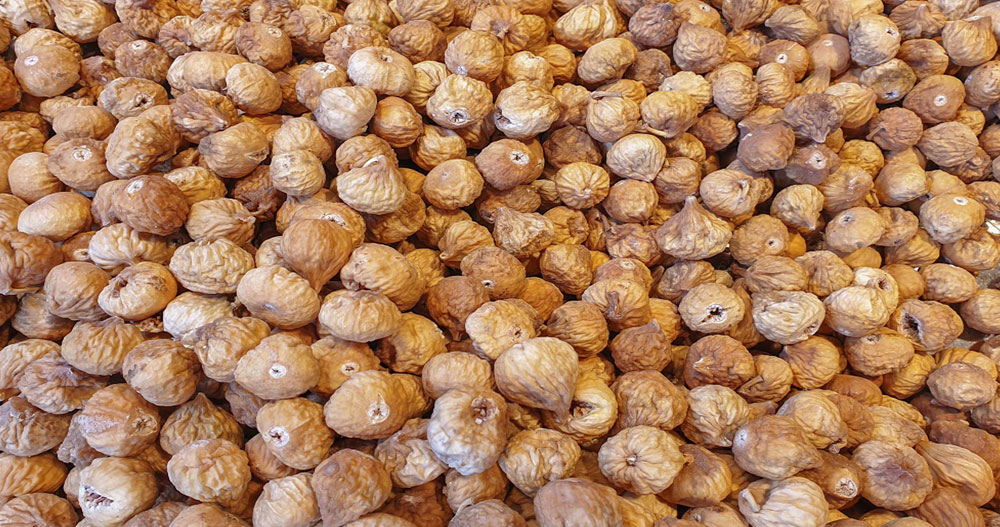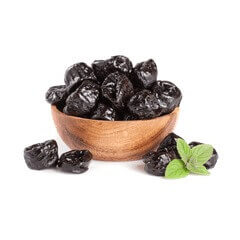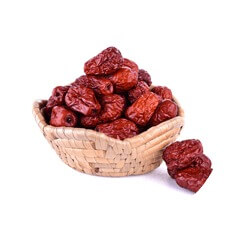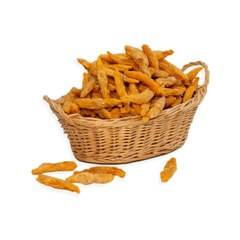Figs are an amazing source of fibre, and they are full of vitamins and minerals. They have a long history and are essential for good health. Let’s discover this sacred fruit, its health benefits and its recipes.
The Little Story of the Fig
The fig may not be juicy, but it is a delicious fruit with a subtle aroma and pleasant taste. It comes in four main colours: white, green, red, and purple/black. Figs have an oval or pear-like shape with a thin skin that encloses green or purple flesh containing hundreds of seeds, which are actually miniature fruits. They are tender, slightly fibrous, and must be handled gently. You can also buy dried figs, making them a nutritious and sweet snack that can be enjoyed year-round. In the past, figs were used as a natural sweetener before the invention of refined sugars.
The fig tree has always held an important place in history, more particularly in the mythologies of the Mediterranean basin. Indeed, the fig tree is one of the five fruit trees of the promised land with the vine, the pomegranate, the olive and the date palm. The fig tree is also native to the Middle East and regions bordering the Mediterranean. Its scientific name, Ficus Caria, was given to it by the Greeks, who believed the tree came from the region of Caria, an ancient district of Anatolia. Finally, in religions, it is also often the symbol representing the sciences!
A Particular Pollination Process
Did you know that the fig tree does not produce fruits but rather inverted flowers? Its flowers actually grow inside a rigid shell, like the fig we know today. The small filaments found inside are, therefore, flowers, which, once fertilized, will give edible fruits.
But then, how are these flowers pollinated? Well, by a wasp! And more precisely, by a “fig tree wasp.” Indeed, to pollinate a fig, a wasp must enter it through a small opening provided for this purpose. Then, when it enters it, it breaks its wings and antennae. And can, therefore, no longer come out. The wasp is then unfortunately condemned to die inside this envelope. But don’t worry; the wasp has then dissolved thanks to enzymes which transform it into protein!
The Different Varieties
Today, there are no less than 700 varieties of figs, which are classified into three categories: green (which can also be white), gray (or also red) figs and black (or purple) figs.
Nutritional Composition
An 80g serving of fresh figs counts as one of your five fruits and vegetables to eat per day, which is about two medium-sized fruits. Only 30g of dried fruit counts as one of your five fruits and vegetables a day because that would equal 80g of fresh fruit.
Before the days of refined sugars, figs were used as a natural sweetener.
Consume fresh figs when it’s in season. It is even richer in minerals and antioxidants. Reserve the dried fig in the winter when you feel tired or when exercising regularly.

The Benefits of Figs on Our Health
Promotes Digestion
In order to nourish and tone the intestines, figs are recommended by experts. They act as a natural laxative due to their high fibre content. The fibre they provide also has prebiotic properties, nourishing gut bacteria and supporting a healthy gut environment, which improves digestive well-being.
Rich in Antioxidants
Behind its crumpled look, the fig is a powerful antioxidant that acts as much on vision as on the skin and mucous membranes. It is, therefore, your youth asset, and you can consume it all year round!
It is also an ally for the health of your bones because it contains calcium and potassium. It can therefore reinforce a lactose-free diet, for example.
The ripe figs are rich in protective plant compounds called polyphenols. These compounds have protective antioxidant properties, meaning they help prevent oxygen from reacting with other chemicals and damaging cells and tissues. They are essential for the management of oxidation.
Maintains Healthy Blood Pressure
Often we consume too much sodium (salt), which is found in processed foods or dishes. High sodium intakes can lead to potassium deficiencies, and this imbalance can lead to high blood pressure. A diet enriched with fruits and vegetables naturally increases potassium levels. This is intended to help manage blood pressure.
Regulates Intestinal Transit
Thanks to its high fibre content, especially in its dry form, the fig allows good intestinal transit. However, be careful not to consume too much, as it could have a laxative effect.
Prevents Hypertension
Still, thanks to its high fibre content, the fig has the benefit of preventing the risk of hypertension, so it is to be used in prevention!
If you’re looking for an idea for a balanced snack or a healthy breakfast on the go and you love figs, you’ll love our fig and apricot granola in snack format!
Promotes Bone Health
Did you know that figs are an excellent source of bone minerals such as calcium, magnesium, and phosphorus? In fact, they are especially rich in calcium, containing 3.2 times more than other fruits. Additionally, the potassium found in figs can help offset the loss of calcium caused by a high salt diet, keeping the calcium in your bones and reducing the risk of osteoporosis.
Improves Diet Quality and Helps With Weight Management
Naturally rich in dietary fibre and full of vitamins and minerals, figs can be a useful dietary supplement to improve the nutrient density of your diet. Thus, they can help you manage your weight. Fibre-rich foods make you feel fuller and can reduce hunger and cravings, while key nutrients improve blood circulation.
How to Store Figs?
When buying figs (preferably organic), choose those that are most ripe because they will not ripen later. Then they must be consumed quickly (within 3-4 days) because they are quite fragile.
You can keep them in the fridge to keep them a little longer or dry them on a dehydrator if you have one. You can also dry them in the sun, but it’s a bit complicated because you have to make sure that there is no humidity.
How to Consume Them?
Fresh, you can eat them raw and with the skin on, provided you wash it well beforehand. They go very well with savoury dishes, whether baked or fried. Dried, they make a perfect snack.
Are Figs Safe For Everyone?
If you are allergic to birch pollen, you may cross-react to certain fruits, including figs. Fig trees also contain natural latex, which some people are allergic to.
If you’ve never eaten figs before, consume them in moderation at first, as they can have a laxative effect if you eat too many.
Sweet, soft and crunchy in places, it also gives off a sweet, sweet smell. In addition to being delicious, the dried fig has many benefits. Fruit with low caloric intake and rich in fibre and antioxidants, we tell you all about its secrets!
Did you know? The dried fig is the sweet delicacy of the sportsman! With its low glycemic index and its concentrated energy, it provides all the minerals necessary for the practice of sporting activity.
More interesting than most fruits, the fig provides about 67 calories per 100 g against 86 for a classic fruit. In addition, thanks to the fibres and vegetable proteins contained in the fruit, it represents a great appetite suppressant. However, be careful to do just what is necessary!
Figs Are Best For Your Health.
The fig, which has about 69 calories per 100 g, is a real source of vitamins, minerals and antioxidants (most of which are concentrated in the skin!).
Indeed, it is a source of potassium (200 mg per 100 g), necessary for the proper functioning of our cells in general, and plays an important role in the activation of nerve and muscle cells. With approximately 57 mg of calcium per 100 g, it also contributes to the good maintenance of our bone and muscle mass and participates in the maintenance of a normal heart rate, thanks to the role of calcium on cardiac contraction. It also provides an interesting contribution of copper, which contributes to the formation of red blood cells and intervenes in the maintenance of the quality of the cartilages of the body and in the mineralization of the bone.
On the vitamin side, there are a large number of B vitamins, essential for maintaining the functioning of the central nervous system and protein synthesis and also have a very important role in energy production.
The fig, and more particularly its skin, is full of antioxidants! We find flavonoids and carotenoids protect our cells from oxidative stress and contribute to the good elasticity of our skin.

The Fig in the Kitchen
Fresh, dried, in a sweet or savoury version. The fig is a real treasure in the kitchen! In sweet, it will be perfect for any type of preparation: jam, cake, crumble, or tart. And in the savoury version, the fig goes perfectly with all kinds of white meats and cheeses, in particular mozzarella and goat cheese.
Best Anti-Waste Recipes with Figs
Although delicious, the fig is one of the most fragile fruits! And unfortunately, it only keeps for a very short time. Indeed, you can only keep them for 48 hours in the vegetable drawer of your refrigerator. Of course, you can always freeze them if you want to reuse them later, but a question arises when they already start to spoil. What to do with our little withered figs on our arms?
A Tapenade
For about one bowl:
- 100 g of figs
- 80g pitted black olives
- One clove of garlic
- 3 tbsp olive oil
- 1 tbsp balsamic vinegar
- a squeeze of lemon juice
- salt and pepper
Preparation:
- Coarsely chop the figs, garlic and black olives and blend everything in a blender until you obtain a thick paste.
- Then add the olive oil, lemon juice and balsamic vinegar and continue blending for a few seconds.
- Add salt and pepper.
A Fig and Onion Chutney
For a jar:
- 200 g of figs
- ½ red onion
- 1 tsp chilli powder
- One clove of garlic
- Five fresh basil leaves
- 25g brown sugar
- 15g cider vinegar
Preparation:
- Cut the figs into pieces. Peel and dice the onion. Peel and chop the garlic.
- Brown everything in a saucepan, then add the chopped basil, chilli powder, sugar, vinegar and 10 cl of water.
- Add salt and pepper.
- Cook over medium heat for fifteen minutes. Feel free to stir often.
- Once cooked, put the chutney in a jar, close and place it in the refrigerator. You can keep it for several weeks!
Fig, Honey and Goat Cheese Sandwiches
For four slices:
- 80g goat cheese
- Four slices of country bread
- Three figures
- 2 tbsp of honey
- One pinch of thyme
- a few walnut kernels
Preparation:
- Preheat your oven to 200°C.
- Cut the goat cheese into slices (or pieces) and the figs into quarters.
- Place a few pieces of goat cheese and fig on your slices of bread.
- Then add a few walnut kernels, sprinkle with thyme and bake at 200°C for 10 minutes.
- Once the sandwiches are out of the oven, coat them with honey and enjoy!
A Jam
For four jars:
- 1.5 kg of figs
- 600 g of sugar
- One vanilla pod
Preparation:
- Wash and drain your figs, then wipe them and prick them.
- Place your figs in the jam bowl with the sugar and the split vanilla pod, then mix. Add a glass of water if needed.
- Bring to a boil, skim and cook over very low heat for about 2½ hours, occasionally skimming as needed until the jam thickens.
- Put everything in jars and let cool. For better conservation, leave your jars to cool and turn them upside down.
Adnoor is the hub for buying Premium Long Grain Basmati Rice, Premium Long-Grain Sella Rice, Brown Super Kernel Basmati Rice, nuts, seeds, and dried fruits. We take pride in saying that we provide the best basmati rice brand in Canada and have been the importers, exporters, wholesalers, distributors, and co-packers of various nuts and grains in Canada for the last 25 years. We aim to provide our customers with quality products, so they keep trusting us. So without wasting time, visit our website and order what you need.







